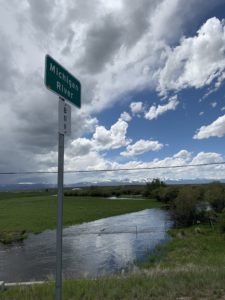 May 23, 2019
May 23, 2019
Memorial Day Weekend is THIS weekend and to celebrate, North Park Anglers is running a 20% off sale on ALL fishing packs and boat bags. Choosing a fishing pack can be both exciting and overwhelming, so today we are here to help compare some different types of packs to help you choose the one that is right for you, or help you choose one as a gift for someone else.
Pack Style: Hip/Lumbar
Best Use: Daily fishing, walk/wade
Hip and lumbar pack styles are typically smaller packs that work best for carrying gear for a single angler. The main pockets are typically attached to a belt that sits on your hips, often times with extra small pockets on the sides/front of the belt. The main load is distributed to your hips. Most hip and lumbar packs come with an extra shoulder strap that you can put diagonally across your body for extra stability and easier net storage. They typically have multiple pockets with lots of organizing pockets. Most have room for multiple fly boxes, 1-2 outside water bottle pockets, outside straps for strapping and carrying an extra layer like a rain jacket, as well as extra pockets/space for snacks, sunscreen, tools, split shot and other fishing necessities. We recommend attaching an outside tippet holder that hangs off the pack to save space.
Pack Style: Sling
Best Use: daily fishing, guiding, walk/wade
Sling packs are typically larger packs, best for carrying gear for 1-3 anglers depending on what size you decide on. The main pocket is a larger, backpack-like pocket with minimal organizational storage. However, most sling packs have smaller additional pockets with lots of organization storage on the inside. Sling packs are worn cross-body style, distributing the weight on the shoulder. Most have room for multiple fly boxes, waters, sunscreen, snacks and other fishing gear for more than one person. They work well for one angler, but if you’re a notorious over-packer you may want to choose a smaller sling style or a different pack. These packs are also good for guiding or for taking out a beginner who doesn’t have much of their own gear yet.
Pack Style: Vest
Best Use: daily fishing, walk/wade
Fishing vests have been around since the beginning of fly fishing and were the OG packs for anglers. Most fit like a cropped vest with multiple pockets on both sides of the front, the weight being distributed onto both shoulders. These packs are best for a single angler as they are meant to be more minimalist and carry only the essentials, however more modern vests have the ability to carry lots of gear while still maintaining a minimalist design.
Pack Style: Backpack
Best Use: daily fishing, walk/wade
Fishing backpacks function like a normal backpack, with large pockets and multiple interior organizational pockets. With lots of storage, backpacks are ideal for guiding or carrying gear for multiple anglers. Many fishing companies these day customize their backpacks to carry fishing specific accessories with easy access. Some even have detachable waist belts to carry your fishing gear so you can put other items like jackets, lunch, water, and a camera in the main compartment.
Pack Style: Backpack Vest
Best Use: daily fishing, walk/wade
A backpack vest is exactly what is sounds like, a fishing vest with a backpack. These are great for guiding or carrying gear for multiple anglers as they can hold you fishing gear in the vest portion for easy access and the backpack can be used for extra layers, water, lunch, and a camera.
Pack Style: Chest
Best Use: Daily fishing, walk/wade, close distance trips
Chest packs fit over the head like, kind of like a closed vest. They typically have a little bit less storage than a hip/lumbar pack, so they are ideal for a single angler who enjoys carrying minimal gear and going on quick outings of short time and distance. They are typically very adjustable to accommodate extra layers, or maybe that extra size of cold pizza you had at lunch.
Pack Style: Boat Bag
Best Use: River floats, lake fishing from a boat, gear storage
Boat bags are great for anyone who is a frequent boat user or is looking for a place to store their extra gear they don’t carry in their pack all the time. They can hold multiple fly boxes and suitcases as well as lots of additional tools and great. These are great for guides who use a boat often to have easy access to all of their needs right at their feet or side. They’re also great for travel and storage to keep all of your gear/extra gear in once organized place.
Now that you know about all the different styles of packs and what their best uses are, there is one last question to ask yourself…waterproof or non-waterproof? The first thing you need to consider with this question is your price point. Waterproof packs often have a heftier price tag attached to them, but there are a lot of benefits to them. If you’re short (and I’m speaking from experience) a waterproof pack might be a great option for you. Often times when wading into lakes or crossing rivers, shorter people’s packs are more prone to getting wet. I have completely dunked my hip pack on multiple occasions in both lakes and rivers and have had to spend hours cleaning out, drying, and reorganizing my pack to see what was salvageable and what was not. Waterproof packs are also great for sticking out rain or snowstorms and keeping all of your interior valuables safe and dry. On the other side, non waterproof packs are often times more economically priced and still perform at a high level. The only minor downsides to going waterproof are there are typically not as many exterior pockets and the waterproof zippers can sometimes be difficult to open and close one handed.
Choosing a pack should be a fun and exciting experience, and the staff at North Park Anglers are here to help. Stop in the shop this Memorial Day weekend and let us help you pick a pack that is right for you, plus receive 20% off and use the extra cash to help you start filling that pack!
Written by: Taylor Martin





















